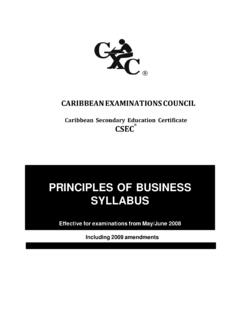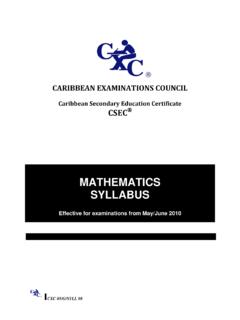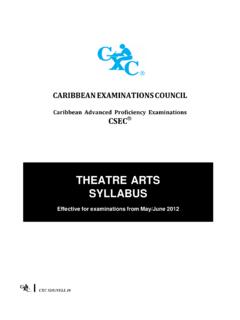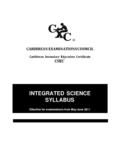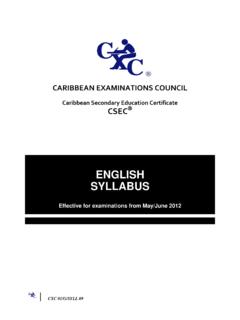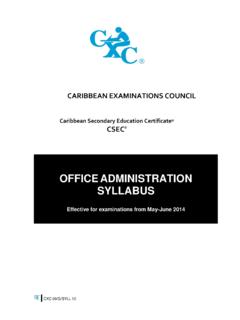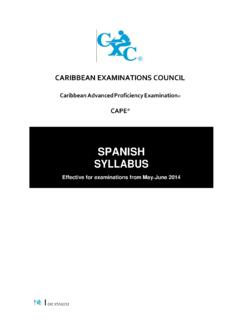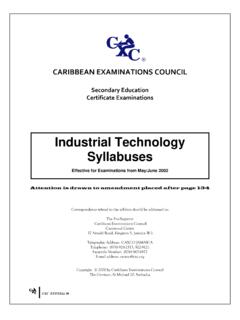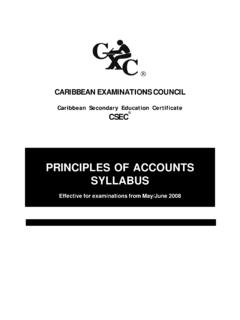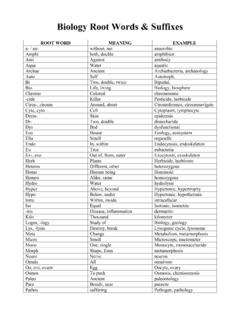Transcription of HUMAN AND SOCIAL BIOLOGY SYLLABUS
1 CARIBBEAN EXAMINATIONS COUNCIL. Caribbean Secondary Education Certificate CSEC . HUMAN AND SOCIAL BIOLOGY . SYLLABUS . Effective for examinations from May/June 2011. CXC 35/G/SYLL 09. Published by the Caribbean Examinations Council 2010, Caribbean Examinations Council All rights reserved. No part of this publication may be reproduced, stored in a retrieval system, or transmitted in any form, or by any means electronic, photocopying, recording or otherwise without prior permission of the author or publisher. Correspondence related to the SYLLABUS should be addressed to: The Pro-Registrar Caribbean Examinations Council Caenwood Centre 37 Arnold Road, Kingston 5, Jamaica, Telephone: (876) 630-5200. Facsimile Number: (876) 967-4972. E-mail address: Website: Copyright 2009, by Caribbean Examinations Council The Garrison, St Michael BB11158, Barbados CXC 35/G/SYLL 09.
2 Contents RATIONALE .. 1. AIMS .. 1. GENERAL OBJECTIVES .. 2. SUGGESTED TIME-TABLE ALLOCATION .. 2. ORGANIZATION OF THE SYLLABUS .. 3. CERTIFICATION .. 3. DEFINITION OF PROFILE DIMENSIONS .. 3. FORMAT OF THE EXAMINATION .. 4. REGULATIONS FOR PRIVATE CANDIDATES .. 4. REGULATIONS FOR RESIT CANDIDATES .. 4. SECTION A - LIVING ORGANISMS AND THE 5. SECTION B - LIFE PROCESSES .. 8. SECTION C - HEREDITY AND VARIATION .. 21. SECTION D - DISEASE AND ITS IMPACT ON 23. SECTION E - THE IMPACT OF HEALTH PRACTICES ON THE ENVIRONMENT .. 26. RESOURCES .. 29. GLOSSARY .. 30. CXC 35/G/SYLL 09 2. This document CXC 35/G/SYLL 09 replaces CXC 35/G/SYLL 04 issued in 2004. Please note that the SYLLABUS was revised and amendments are indicated by italics. First Issued 2004. Revised 2009. Please check the website for updates on CXC's syllabuses. CXC 35/G/SYLL 09 3. T. HUMAN and SOCIAL BIOLOGY RATIONALE.
3 HUMAN beings require knowledge of the ways in which the HUMAN body functions, of the interdependence of living things, and of the ways the total environment functions to support life on earth in all its forms, in order to make intelligent decisions on matters at home, at work or in society, which routinely affect their health and, therefore, the quality of their lives. The study of HUMAN and SOCIAL BIOLOGY provides students at secondary schools with an opportunity to begin acquiring this knowledge. HUMAN and SOCIAL BIOLOGY is concerned with the study of the structure and functioning of the HUMAN body. It also involves the application of biological principles, knowledge and skills, and technological advances, to the maintenance of health and to solve the problems of living together. The subject incorporates the view that HUMAN beings have a responsibility to their environment and, as such, have an obligation to conserve, protect, maintain and improve its quality.
4 The CSEC HUMAN and SOCIAL BIOLOGY SYLLABUS is designed to allow students to work individually and cooperatively, utilizing theoretical concepts of the course in interactive and practical activities. Students are expected to apply investigative and problem-solving skills, be effective in communicating scientific knowledge and demonstrate an appreciation for all living organisms in their environment. The CSEC SYLLABUS in HUMAN and SOCIAL BIOLOGY provides Caribbean students with a foundation for further study in fields where an understanding of the structure and functioning of the HUMAN body and the application of biological principles to the maintenance of health have relevance. It also helps to provide students with knowledge, skills and attitudes that are important for maintaining a healthy lifestyle. This SYLLABUS will contribute to the development of the Ideal Caribbean Person as articulated by the CARICOM.
5 Heads of Government in the following areas: respect for HUMAN life and awareness of the importance of living in harmony with the environment; multiple literacies; independent and critical thinking and the innovative application of science and technology to problem solving. Based on the UNESCO Pillars of Learning, this course of study will also contribute to a person who will learn how to do, learn to live together and learn to transform themselves and society. AIMS. The SYLLABUS aims to: 1. develop an understanding of the structure and functioning of the HUMAN body;. CXC 35/G/SYLL 09 1. 2. increase awareness about the interdependence of living things as they live in harmony with the environment;. 3. develop competencies that will enable students to adopt healthy lifestyles;. 4. develop experimental and data interpretation skills;. 5. increase awareness of technological advances.
6 6. provide a foundation for further study or specialised training in fields such as, nursing, physiotherapy or dietetics, which require an understanding of the structure and functioning of the HUMAN body and the application of biological principles to the maintenance of health and healthy living. GENERAL OBJECTIVES. On completion of this SYLLABUS , students should: 1. understand the processes that govern the interactions of organisms in the environment and the processes by which life is perpetuated;. 2. understand the nature of the interdependence of the processes, structures and functions of the major systems, within an organism in the maintenance of health;. 3. understand the role of nutrition in helping living organisms to obtain their energy and satisfy their physical needs;. 4. understand the mechanisms by which characteristics pass from parent to offspring.
7 5. become aware of the importance of genetic variation;. 6. understand the basic concepts of HUMAN well-being and disease;. 7. appreciate the nature of the relationship between HUMAN beings and their environment;. 8. appreciate that the environment is fragile and there is need to preserve it;. 9. appreciate the contribution of modern technology to the maintenance of good health. SUGGESTED TIME-TABLE ALLOCATION. It is recommended that a minimum of five 40-minute periods per week over two academic years or the equivalent be allocated to the SYLLABUS . CXC 35/G/SYLL 09 2. ORGANIZATION OF THE SYLLABUS . The SYLLABUS is organised under five main sections: 1. Living organisms and the environment. 2. Life processes. 3. Heredity and variation. 4. Disease and its impact on humans. 5. The impact of health practices on the environment. In this SYLLABUS , the Specific Objectives which are denoted by an asterisk are particularly suitable for practical activities.
8 However, the practical activities need not be limited to these objectives. CERTIFICATION. The SYLLABUS will be examined at the General Proficiency only. Candidates will be awarded an overall grade reported on a 6-point scale. In addition to the overall grade, candidates' performance will be reported by a letter grade under the profile dimensions, Knowledge and Comprehension, and Use of Knowledge. DEFINITION OF PROFILE DIMENSIONS. On completion of the SYLLABUS , students are expected to develop skills under two profile headings: (i) Knowledge and Comprehension (KC);. (ii) Use of Knowledge (UK). Knowledge and Comprehension (KC). The ability to: (i) identify, remember and grasp the meaning of basic facts, concepts and principles;. (ii) select appropriate ideas, match and compare facts, concepts and principles in familiar situations. CXC 35/G/SYLL 09 3. Use of Knowledge (UK).
9 The ability to: (i) use facts and apply concepts, principles and procedures in familiar and new situations;. (ii) interpret and draw inferences from practical laboratory exercises;. (iii) analyse, organise and evaluate information in an effort to make reasoned judgements and recommendations. FORMAT OF THE EXAMINATION. Candidates will be required to take Paper 01 and Paper 02. Paper 01 Sixty multiple-choice items drawn from all areas of the SYLLABUS . (1 hour 15 minutes). Paper 02 Section A - four compulsory structured questions drawn from all areas (2 hours) of the SYLLABUS . One question will be an investigative type/practical oriented question. Each question is worth 15 marks (6 KC, 9 UK). Section B - two compulsory structured essay questions drawn from all areas of the SYLLABUS . Each question is worth 15 marks (6 KC, 9 UK). MARK AND WEIGHTING ALLOCATION FOR THE PROFILE DIMENSIONS.
10 Profile dimension Paper 01 Paper 02 Total Raw Score % Raw Score % Raw Score %. Knowledge and Comprehension 60 40 36 24 96 64. Use of Knowledge - 54 36 54 36. TOTAL 60 40 90 60 150 100. REGULATIONS FOR PRIVATE CANDIDATES. Candidates who are registered privately will be required to sit Paper 01 and Paper 02. Private candidates must be entered through institutions recognized by the Council. REGULATIONS FOR RESIT CANDIDATES. Resit candidates will be required to sit Paper 01 and Paper 02. Resit candidates must be entered through a school or other approved educational institution. CXC 35/G/SYLL 09 4. SECTION A: LIVING ORGANISMS AND THE ENVIRONMENT. SPECIFIC OBJECTIVES EXPLANATORY NOTES. Students should be able to: 1. describe the characteristics of living Nutrition, respiration, excretion, growth, organisms; irritability, movement, reproduction. 2. compare the structures of an unspecialized Basic structure of unspecialized plant cell, animal plant and animal cell and selected cell and microbes.
